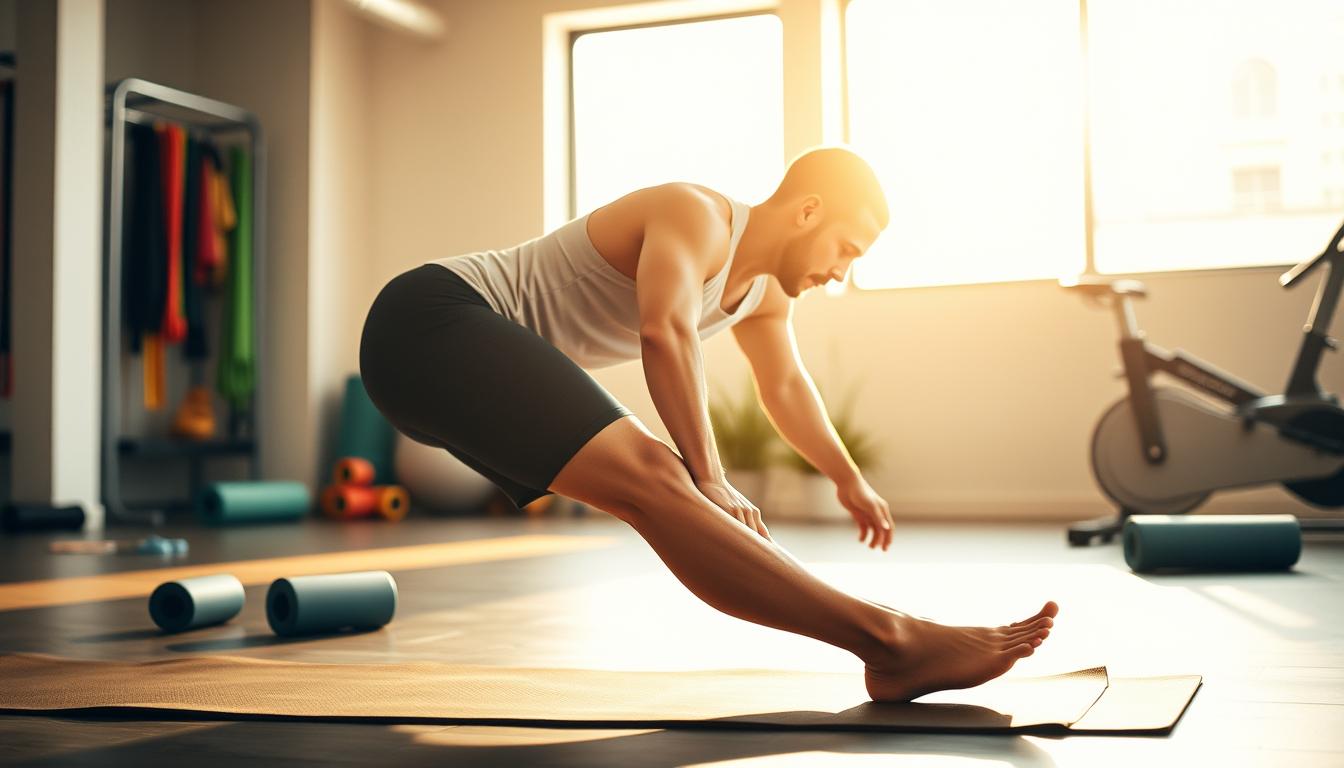Runner’s knee pain, medically known as patellofemoral pain syndrome, is a common issue affecting many athletes and active individuals, causing discomfort around or behind the kneecap. This condition can significantly hinder one’s ability to engage in physical activities, including running. Understanding the recovery time and rehabilitation process is crucial for those affected.
For individuals suffering from this condition, a well-structured rehabilitation program is essential. The recovery process involves not just alleviating the pain but also addressing the underlying causes and preventing future occurrences.
This comprehensive guide will walk you through the typical recovery timeline, causes, symptoms, diagnostic procedures, and effective treatment strategies for runner’s knee. By understanding these aspects, individuals can better navigate their rehabilitation journey.
Key Takeaways
- Understanding the causes and symptoms of runner’s knee is crucial for effective recovery.
- The recovery timeline varies based on individual factors and injury severity.
- A well-structured rehabilitation program is essential for optimal recovery.
- Diagnostic procedures include assessing lower body alignment and muscle imbalances.
- Treatment involves pain management, strengthening exercises, and preventive measures.
Understanding Runner’s Knee: Causes and Symptoms
Understanding the causes and symptoms of runner’s knee is crucial for effective recovery. Runner’s knee, a condition that affects many runners and athletes, is characterized by pain around or behind the kneecap.
What Is Runner’s Knee?
Runner’s knee, also known as patellofemoral pain syndrome, refers to pain around or behind the kneecap. It is a common condition among athletes who participate in activities that involve running, jumping, or repetitive knee movements.
Common Causes of Runner’s Knee
The causes of runner’s knee can vary, but they often include overuse, misalignment of the kneecap, and muscle imbalances. Activities that involve repetitive knee bending, such as running or squatting, can exacerbate the condition.
Recognizing the Symptoms
Symptoms of runner’s knee include pain when walking or going down stairs, pain that worsens after sitting for a long time with bent knees, and discomfort around the kneecap. Other symptoms may include:
- Pain that worsens after activities that bend and bear weight on the leg
- Tenderness when touching the kneecap
- A clicking or grinding sound when bending or straightening the knee
- Swelling around or behind the kneecap area
Diagnosing Runner’s Knee
Diagnosing runner’s knee is a critical step in treating the condition effectively. A proper diagnosis ensures that the treatment plan addresses the root cause of the knee pain.
When to See a Doctor
If you’re experiencing persistent pain around or behind your kneecap, it’s essential to consult a doctor. The onset of symptoms such as swelling, redness, or instability in the knee also warrants medical attention.
Diagnostic Tests and Procedures
A diagnosis of runner’s knee involves a comprehensive patient interview and a physical examination of the knee. The doctor may perform tests like the Clarke test to assess patellofemoral pain. Imaging studies such as X-rays, MRIs, or CT scans may be ordered to rule out other conditions.
| Diagnostic Test | Purpose |
|---|---|
| X-rays | Detect fractures or signs of arthritis |
| MRIs | Reveal soft tissue injuries like meniscus or ligament tears |
| CT scans | Identify structural abnormalities |
Initial Treatment Strategies
Effective management of runner’s knee starts with understanding the appropriate initial treatment strategies. The goal is to reduce pain, improve patellar tracking, and return the individual to their previous activity level.
The RICE Method Explained
The RICE method, standing for Rest, Ice, Compression, and Elevation, is a widely recognized approach for treating injuries like runner’s knee. It helps in reducing swelling and pain. Resting the knee and avoiding activities that aggravate the condition is crucial.
Pain Management Options
For managing pain, over-the-counter non-steroidal anti-inflammatory drugs (NSAIDs) like ibuprofen and naproxen are effective. They reduce pain and inflammation associated with runner’s knee. Here’s a comparison of common pain management options:
| Medication | Effectiveness | Side Effects |
|---|---|---|
| NSAIDs (e.g., ibuprofen, naproxen) | Highly effective for reducing pain and inflammation | Potential digestive discomfort |
| Acetaminophen (Tylenol) | Effective for pain relief | Fewer side effects compared to NSAIDs |
| Topical analgesics | Provides localized pain relief | Fewer systemic side effects |
It’s essential to consult with a healthcare provider before starting any treatment regimen, especially for a runner aiming for recovery.
Typical Runners Knee Recovery Time

The recovery time for runner’s knee can vary significantly based on several factors, including the severity of the injury and adherence to the treatment plan. Generally, people can expect to recover within a certain timeframe, but it’s essential to understand the factors that influence this duration.
Influencing Factors
Several factors can affect the recovery duration of runner’s knee, including the severity of the condition, the effectiveness of the treatment plan, and the individual’s overall health. Adhering to a well-structured treatment plan is crucial for optimal recovery. For more information on preventive measures, visit Premier Medical Associates.
Recovery Timeline
The recovery process for runner’s knee can be broken down into several stages. Here’s an overview of what to expect:
| Week | Recovery Stage | Expected Progress |
|---|---|---|
| 1-2 | Reducing inflammation and pain | Noticeable reduction in acute symptoms |
| 2-4 | Gentle strengthening and stretching | Resumption of light, modified activities |
| 4-6 | Progressing to challenging exercises | Significant improvement in approximately 60-70% of patients |
| 6-8 | Reintroducing running or sport-specific activities | Most uncomplicated cases resolve within this timeframe |
For a more detailed rehabilitation plan, consider visiting The Physiotherapy Place for expert advice on runner’s knee recovery.
Rehabilitation Exercises for Runner’s Knee
Runner’s knee rehabilitation is not just about healing the knee; it’s about strengthening the entire lower limb through targeted exercises and training programs. A comprehensive rehabilitation plan is crucial for a full recovery.
Strengthening Exercises
Strengthening the muscles around the knee is vital for recovery. This includes exercises like squats, lunges, and leg press that target the quadriceps, hamstrings, and glutes. Proper form is essential to avoid further injury.
- Squats: Strengthens quadriceps, hamstrings, and glutes
- Lunges: Targets quadriceps, hamstrings, and glutes
- Leg Press: Strengthens quadriceps, hamstrings, and glutes
Stretching Routines
Stretching is equally important as strengthening. It helps improve flexibility and reduce muscle tension. Focus on stretches for the quadriceps, hamstrings, and IT band.
- Quadriceps Stretch: Stand with one hand against a wall for balance, grab your ankle, and pull your heel towards your buttocks.
- Hamstring Stretch: Sit on the floor with your legs straight out, lean forward, and reach for your toes.
Progressive Training Plan
A progressive training plan involves gradually increasing the intensity of your workouts. This can be achieved by adding resistance, increasing repetitions, or introducing more complex exercises.
For example, start with walking/jogging intervals on flat surfaces and gradually progress to varied terrain. Incorporate cross-training activities like swimming, cycling, or elliptical training to maintain cardiovascular fitness while reducing the impact on the knee joint.
Can You Continue Running During Recovery?

The dilemma many runners face when diagnosed with runner’s knee is whether to continue running or halt their training entirely. According to Dr. Frantz,
“It seems simple, but if it hurts, then don’t do it.”
This advice serves as a foundational principle for determining whether to continue running during recovery.
Safe Activities During Rehabilitation
During rehabilitation, it’s crucial to maintain some level of activity without exacerbating the condition. Low-impact activities such as cycling or swimming can be beneficial alternatives to running.
Signs You’re Pushing Too Hard
Several signs indicate that you’re pushing too hard during recovery. These include:
- increased pain during or after activity
- persistent pain lasting more than 24 hours
- new or worsening swelling around the knee
- changes in running gait or movement patterns
- pain that worsens with each training session
- difficulty with daily activities after exercise
- sleep disturbances due to knee pain
Preventing Runner’s Knee Recurrence
A proactive approach to preventing runner’s knee involves a combination of proper running form, appropriate footwear, and regular maintenance exercises. By understanding the causes of runner’s knee and implementing targeted preventive measures, runners can significantly reduce the risk of recurrence.
Proper Running Form and Footwear
Maintaining proper running form is crucial, as it keeps the core tight and prevents excessive leaning forward or backward. Proper footwear can correct the alignment of the kneecap to the trochlear groove and absorb shock upon heel strike, reducing the risk of injury. Quality running shoes can also correct issues like flat feet.
Cross-Training Benefits
Incorporating cross-training into a running regimen can help prevent overuse injuries by varying the stress on the muscles and joints. Activities like cycling or swimming can be excellent alternatives that maintain cardiovascular fitness without the high-impact stress of running.
Long-Term Maintenance Strategies
Long-term maintenance involves regular strengthening exercises for the quadriceps, hamstrings, and hip muscles. It’s also essential to schedule regular rest days and listen to your body to prevent overuse injuries. By adopting these strategies, runners can enjoy their sport while minimizing the risk of runner’s knee recurrence.
Conclusion
The journey to overcoming runner’s knee involves understanding its causes, applying appropriate treatment, and adopting long-term preventive strategies. Runner’s knee is a common but manageable condition that typically resolves within 4-8 weeks with appropriate treatment and rehabilitation strategies. Understanding the specific causes of your runner’s knee is crucial for effective treatment and preventing recurrence.
A progressive rehabilitation program focusing on strengthening, stretching, and proper movement patterns is essential for complete recovery. While recovery requires temporarily modifying activities, most people can return to running and other high-impact exercises with proper rehabilitation and preventive measures. Long-term prevention strategies, including cross-training and proper footwear, significantly reduce the risk of recurrence.
With patience and adherence to a comprehensive treatment plan, most runners can overcome patellofemoral pain syndrome and return to their preferred activities pain-free.


